Bowen Therapy is a dynamic muscle release therapy, which originated in Australia by Tom Bowen. A Bowen treatment
involves light moves over muscles, tendons and ligaments which, applied to very specific points on the body with
significant pauses or rests between each series of moves. These cross-fibre moves send a message via the nervous
system. This information is processed and the body can make necessary adjustments over the next few days, altering
tension levels in the musculature. The body is able to correct or ‘re-set’ itself.
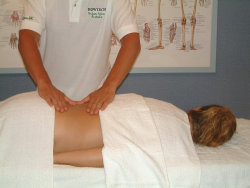
Most clients experience that with only a few treatments their conditions strongly improve or disappear completely.
Long lasting conditions may require more treatments. Periodical treatments (for example every month) help prevent
health problems and many clients choose to do so, since “prevention is better than cure”.
In the text below information is provided about the Bowen Therapy. The text can be read sequentially, but by clicking
on a chapter you jump straight to the specific subject.
It is suitable for any age group from newborn babies to the very elderly. It is gentle and non-invasive and can be
done through light clothing.

Bowen Therapy is also suitable for baby's
What to expect from a Bowen treatment
What conditions can Bowen Therapy help
How does Bowen Therapy work?
Recommendations with a Bowen
treatment
Testimonials clients
History of Bowen Therapy
What to expect from a Bowen
treatment
At the start of the first session an inventory is made of your medical history, your conditions and any past injuries,
accidents or surgery. With this data the Bowen Therapist decides the approach of your treatment. The treatment itself
takes about 30 to 45 minutes.
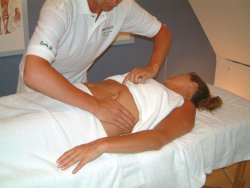
Bowen 'move' over the rectus abdominis
The treatment itself takes place in a relaxed atmosphere. When the body is in a relaxed state, it is able to respond
more favourably to the work. Normally you are treated on a comfortable treatment couch. Though it is also possible to
treat clients sitting up (for example sitting in a wheel chair). The goal is always that the client is in the most
comfortable position. Often relaxing background music is played to increase the feeling of relaxation even more and
to subdue possible disturbing background sounds. Therefore it is not surprising that occasionally clients fall asleep
during a treatment.
A Bowen treatment differs somewhat from other forms of therapy because of the regular breaks. In between each set of so
called Bowen ‘moves’ the therapist usually leaves the room for a few minutes. These are very deliberate pauses as
they allow the body time to respond to the work before proceeding on to the next set of moves. When the therapist
would stay in the room, a conversation could easily be started and the client will, consciously or unconsciously, feel
observed and trace where the therapist is or what the therapist is doing.
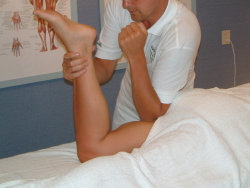
Bowen 'move' over the hamstrings
In general most clients experience that they very easy and quickly relax. Often they feel warmth, tingles, etc. on
the spots where work is done, but also might be experienced in other parts of the body. These sensations
are normal, although not necessary for the result. Therefore when you don’t have these experiences, this is no
reason to suspect that the therapy is not a success.
Some examples of conditions reacting well to a Bowen treatment are:
| · Back pain and sciatica | · Stress symptoms |
| · Unequal leg length | · Chronic fatigue and M.E. |
| · Neck and shoulder problems | · Asthma and bronchitis |
| · Knee and ankle problems | · Hay fever and other allergies |
| · Sports injuries | · Digestive problems |
| · RSI and tennis elbow | · Menstrual and hormonal problems |
| · Migraine and headache | · Pregnancy and childhood complaints |
| · Ear- and jaw pain | · Bedwetting (with children) |
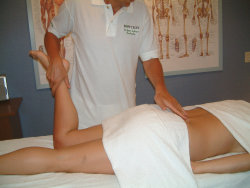
Bowen 'move' over the erector spinae
ATTENTION: Bowen Therapy is not a replacement for a medical treatment or advice, but complements these.
Bowen Therapy is a hands-on, gentle manipulative therapy. It consists of gentle, rolling moves: the so-called Bowen
‘moves’. These Bowen ‘moves’ are usually applied with thumbs and fingers over muscles, tendons and ligaments. The
effect of such an impulse is stimulation of the self-healing capabilities of the body. How this is possible in a
physiological way, you can read in the text below.
The Bowen ‘move’ self consists normally of traction of skin slack to the border of a specific muscle, tendon or
ligament, then hold it for a moment and release the build up tension again with a rolling move. During and after
the move thousands of proprioceptors (posture and movement detectors in muscles and tendons) detects if there is any
deviation. This situation is often developed slowly for example due to a bad posture for years, but can also be
inflicted by a sudden fall or unlucky movement. The Bowen ‘move’ functions here as a catalyst and reports the
deviation through the sensory nerve paths and the spinal cord to the brain. Then the information is processed
via a complex self-corrective feedback mechanism. Next the correcting information is sent back through the spinal
cord and is delivered to the numerous muscles, so that they can return to their original tension and balance.
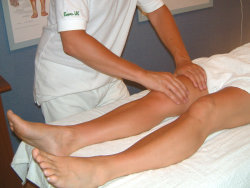
Bowen 'move' over tendon of the vastus lateralis
The preceding physiological explanation of the Bowen ‘move’ shows how during (and after!) a treatment the
self-healing capabilities of our body are activated and stimulated. Also this explains that the gentle
manipulating moves could have an enormous influence on the posture and the functioning of our total body.
It seems surprising that the whole body is affected by a Bowen treatment. A common way to illustrate this, is a
comparison of the body with a circus tent. The spinal cord represents the central pole, the muscles the guy ropes
and the legs the tent poles (see the drawing below). Weakness of the left guy pole (muscle) automatically induces
over tension of the right guy rope (muscle). The tent (person) might still be standing, but is very unstable
(painful, discomfort) and all pillars (spinal cord and the legs) are squint to deal with the problems with the
guy rope(s). Thus a deviation results in more compensating deviations at other places; this of course also is the
same for the correction.

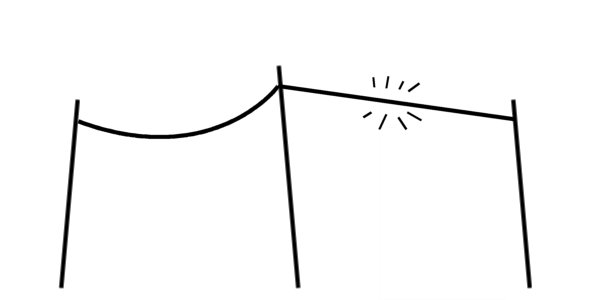
Circus tent as synonym for the body, the left side shows a correct and
right side shows a troubled posture
Applied to the body this mutual dependency goes even further when one realises that also the internal organs and
nerves are surrounded by muscle tissue and that these can be pressurised or blocked by it. Furthermore the body is
designed to compensate for local problems. You could see this as an emergency repair, which consequently isn’t
solved the right way. A weak knee for example, will almost certain result in a compensating pelvis position. This
in it its turn can result in a compensating shoulder position and consequently the person concerned experiences
neck complaints or headaches as a primary condition.
Concluding, it is the body that makes the real corrections after the therapist has brought the current deviation
to the attention of the central nervous system. Any necessary adjustments of the body take place up to a few
days after the treatment.
“The body is a genius and Bowen speaks its language”
Recommendations with a Bowen
treatment
Drink enough water
Our body consists for 70% of water and that makes it essential for our body. It is generally accepted, that we should
drink a minimum of 2 litres a day. After a Bowen treatment this is even more important if possible, because amongst
other body responses, Bowen Therapy stimulates the elimination of toxics. These can be absorbed in the water and leave
the body in a natural way. We are talking about 2 litres of water here; coffee and tea for example don’t count. Even
worse, these dehydrate the body and our body cells and thus muscles perform better when they are hydrated sufficiently.
Keep moving enough
On the day of the treatment it is important, that you stretch your legs once every half hour. Some gentle exercise is
important because this stimulates the lymphatic system. Especially with a profession, which involves sitting all
day it is advisable to do this consciously. On the other hand, the body shouldn’t be overloaded or be exposed to
extreme heat or cold.
Undertake no other therapy
For an optimal result of the Bowen treatment it is also important that in the days before and after the treatment
no other therapies (Physiotherapy, Acupuncture, Massage, and so on) are applied unless there is a medical need for
it. The processing of the Bowen treatment and the following corrections could indeed take place up to a few days
after the actual treatment. Other therapies may nullify the effect of the Bowen treatment, because they also send
a number of signals to the brain. This is also the reason why between two Bowen treatments, there should be a minimum
number of days. A commonly used example to illustrate this is the one of the telephonist. Picking up one phone line
works perfectly, picking up two simultaneous might still work, but picking up three or more makes it next to impossible.
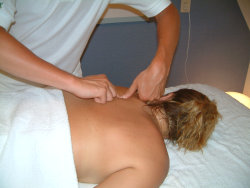
Bowen 'move' over the rhomboideus major
Maintenance
Especially when you are at higher risk due to your work or private situation, consider a regular, for example monthly
‘maintenance treatment’ to prevent health problems. Conditions resulting from incorrect posture (standing on your
feet or car driving), continual lifting (children or heavy loads at work), repetitive strain (computer or office
work) and stress can all be minimized with a monthly Bowen treatment. A car is brought to the garage for preventive
maintenance and our body deserves at least the same level of attention.
With respect to the large number of available testimonials from clients of Bowen Therapy, these are included on a
separate sub page. Click in the navigation column on the left on the link ‘Testimonials clients’ under “Bowen”.
The Bowen Therapy originates from Australia and is developed by Tom Bowen (1916-1982). In the 50’s and 60’s he created
the foundation of what is now known as the Bowen Therapy. A government investigation pointed out, that at his peak
he treated about 13.000 clients a year (that corresponds to 50-60 clients a day!) with very good results.
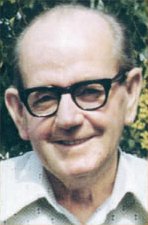
Tom Bowen
It was only after his death that the Bowen Therapy took off. During his life, Tom Bowen worked intensively with Oswald
Rentsch. In these years Oswald Rentsch documented the Bowen Therapy with the promise to spread this therapy over the
world and preserve this therapy for later generations after his death. With this goal, in 1987 Oswald Rentsch founded
the “Bowen Academy of Australia”. He is still connected to the association as Director and Instructor. By now, more
than 17.000 Bowen Therapists have been taught all over the world.
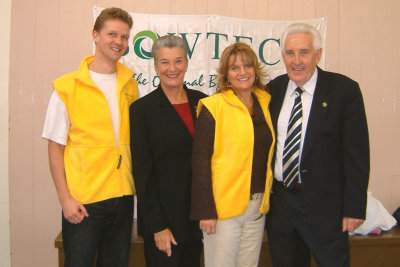
BowenHealth Therapists with Ossie & Elaine Rentsch